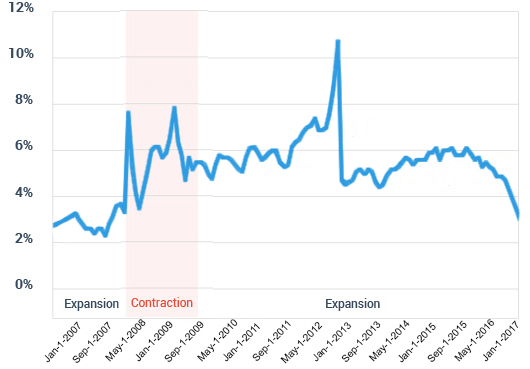The U.S. personal saving rate stood at 3.7% in January of 2017, a bit lower than its 10-year average of 5.5% and well below the recent five-year high of 11% in December 2012. 1
The personal saving rate is the federal government’s estimate of what percent of their incomes U.S. households are saving. But market watchers and economists are mixed on what can be learned from swings in the saving rate.
Why Economists Struggle
They struggle with the personal saving rate because it’s a derivative number — that is, it’s not measured directly. Instead, the Bureau of Economic Analysis derives the saving rate from other estimates. Here’s how it’s calculated: 2
- The Bureau of Economic Analysis subtracts payroll and income taxes from personal income to get disposable personal income.
- The Bureau then subtracts its estimate of personal outlays — expenditures, interest payments, and payments — from disposable personal income to get an estimate of personal saving.
- The Bureau concludes by dividing personal income — the number the Bureau started with — by personal saving.
As currently structured, the U.S. Personal Saving Rate does not include capital gains from the sale of land or financial assets in its estimate of personal income. This effectively excludes capital gains — an important source of income for some.
Fast Fact: Other Measure. Some economists prefer to track gross national savings as a percent of gross domestic product. In 2016, the gross national savings of the U.S. was 18.6%, well below the world average of 26.8%. Source: Central Intelligence Agency, 2017
Gaining Insight
Gaining a bit of insight into a popular economic indicator can help you better understand trends as they are discussed in newspapers and websites. However, don’t let your long-term savings program be influenced by a national number.
Economic Indicator?
The personal saving rate fluctuates with the country’s economic environment.
1,2. Bureau of Economic Analysis, 2017
DISCLAIMER: This website is for informational purposes only and does not constitute a complete description of our investment advisory services or any past performance. This website is neither a solicitation nor an offer to sell securities or investment advisory services except where we are appropriately registered or exempt from such registration. Information throughout this site, whether stock quotes, charts, articles, or any other statement or statements regarding market or other financial information, is obtained from sources which we and our suppliers believe to be reliable. However, we do not warrant or guarantee the timeliness or accuracy of this information. Nothing on this website should be interpreted to state or imply that past results are any indication of future performance. THERE ARE NO WARRANTIES, EXPRESSED OR IMPLIED, AS TO ACCURACY, COMPLETENESS, OR RESULTS OBTAINED FROM ANY INFORMATION POSTED ON THIS OR ANY ‘LINKED’ WEBSITE.
The content is developed from sources believed to be providing accurate information. The information in this material is not intended as tax or legal advice. It may not be used for the purpose of avoiding any federal tax penalties. Please consult legal or tax professionals for specific information regarding your individual situation. This material was developed and produced by FMG Suite to provide information on a topic that may be of interest. FMG Suite is not affiliated with the named broker-dealer, state- or SEC-registered investment advisory firm. The opinions expressed and material provided are for general information, and should not be considered a solicitation for the purchase or sale of any security. Copyright 2016 FMG Suite.
Back





